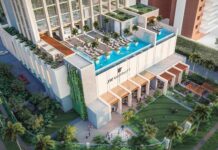In addition to the proposed hotel rooms, two existing hotels have submitted redevelopment plans to the city. The Fairmont Miramar has proposed several versions of their plan to expand the existing property. The latest calls for the renovation of the historic Palisades building and the addition of a four-story building, a six-story building, and a 21-story tower with new hotel rooms, up to 160 residential units, and ground-level retail. The Wyndham Hotel, formerly a Holiday Inn, has announced plans for a three tower design with a viewing deck on each tower. Upon completion, the owner and developer FelCor Lodging Trusts’s $255 million project would include 211 hotel rooms and 25 residential units. However, it’s worth noting that both projects are in the early planning and approval stages and have received significant push back from city planners and Santa Monica citizens which may result in extended project timelines.
In July 2013, it was announced that the Sheraton Delfina will be reflagged Le Meridien Delfina Santa Monica. An undisclosed amount will be invested to refurbish the property to feature the signature Le Méridien Hub lobby experience, large-scale artwork, and other upgrades.
HOTEL MARKET PERFORMANCE
Santa Monica is currently one of the strongest lodging submarkets in the United States. Based on a select set of lodging facilities surveyed by HVS in the market area, Santa Monica hotels in 2012 operated at an average occupancy rate of 83.9 percent with an ADR of $255.89, representing a year-over-year increase from 2011 of 2.7 percent and 5.5 percent respectively. The market’s 2012 average RevPAR was $214.76, an increase of 8.3 percent over the previous year. This puts it on par with the top two markets in the US for ADR – New York City and Oahu. According to the California Lodging Industry Performance published by CH&LA and STR, the Santa Monica/Marina del Ray market year-to-date for June 2013 shows occupancy at 81.3 percent with an ADR of $246.33 and RevPAR of $200.31.12 This market has the highest rates across the board in all of California. HVS projects average occupancy for 2013 to remain close to 85 percent, with positive ADR (+6.5 percent) and RevPAR (+8.1 percent) trends to continue.
Since 2004, market-wide occupancy levels have stayed in the high-70 to low-80 percent range. Even at the bottom of the recession, occupancy rates in Santa Monica hovered in the mid-70s, showing the strength of the market’s lodging fundamentals. According to our market interviews, hoteliers are optimistic for the future of Santa Monica, even with the new supply anticipated to enter the market.
RECENT TRANSACTIONS
Hotel sales in Santa Monica are relatively sparse when compared with all the recent development activity. Even so, high barriers to entry as a result of extremly high land costs and an arduous approval process make the purchase of existing hotels an attractive alternative to construction. The slow pace of hotel transactions indicates the desirabilty of ownership in Santa Monica. Even with historic interest rate lows, hoteliers continue to maintain ownership in their profitable assets.
CONCLUSION
With its attractive oceanside location, robust entertainment and technology industries, multiple tourist demand generators, and high barriers to entry, Santa Monica should continue to be a bright spot in the Greater Los Angeles area for commercial development, particularly hotels.
This market was supplied by HVS with data complied and analyzed at the HVS Los Angeles Office.
Photo Credit: Santa Monica via Bigstock.











Awsome post and right to the point. I am not sure if this is actually the best place to ask but do you guys have any thoughts on where to get some prsansoioefl writers? Thanks